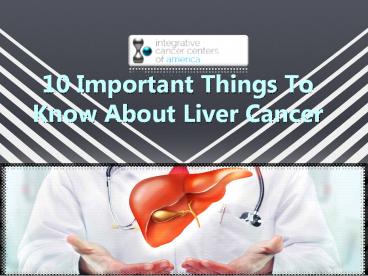10 Important Things To Know About Liver Cancer - PowerPoint PPT Presentation
Title:
10 Important Things To Know About Liver Cancer
Description:
10 Important Things To Know About Liver Cancer – PowerPoint PPT presentation
Number of Views:97
Title: 10 Important Things To Know About Liver Cancer
1
10 Important Things To Know About Liver Cancer
2
- The liver plays an important role in the body
because all blood in the system passes through
it. While acting as a filter for blood, it has
several functions, including eliminating toxins
and converting nutrients into useful forms.
3
- When cancer cells are in the blood, the liver is
an easy target for infestation. As a result, many
people acquire liver cancer metastatically after
it spreads from other areas, although it can also
originate in the liver itself.
4
Nutrition
- As with all illnesses, it is important to
maintain a healthy eating plan to help during
treatment and recovery. Getting adequate vitamins
and minerals is accomplished best through food,
and patients must meet caloric needs with a
balanced diet.
5
- When nausea and vomiting prevent challenges, a
dietician or health care provider can help by
providing suggestions and advice on how to remain
healthy through nutrition. Weight and energy
levels are often monitored and accessed.
6
Prognosis
- The outcome of liver cancer depends largely on if
the cancer is treatable and what that treatment
involves. Other factors include how widespread
the disease is within the body, the size and
number of tumors, and the health of the liver and
surrounding abdominal tissues.
7
- According to the American Cancer Society, there
is a fifteen percent average five-year survival
rate for all stages of the disease. This number
varies among patients and the stage of their
cancer.
8
Pain Control
- Liver cancer and its subsequent surgery or
therapy may cause pain, so it is important to use
safe measures to manage any discomfort.
Medication upon a doctors advice can help, and
although side effects include fatigue and
constipation, they can be remedied.
9
- Radiation acts to reduce the cancer and therefore
can minimize pain. Injections of alcohol can help
manage pain by blocking nerve function in the
abdomen. Natural methods include relaxation,
massage, and acupuncture.
10
Alternative Treatments
- In the medical field, there are not yet any
naturopathic treatments approved, but some
complementary therapies might help patients
undergoing conventional options.
11
- Acupuncture has been shown to help with side
effects like nausea and vomiting. Milk thistle is
a herb with a history linked to liver health and
mistletoe has been used as an herbal remedy.
Caution should be made to preparations using
alcohol and Ginko Biloba.
12
Treatment
- Treatment options depend on the stage of the
cancer and the health of the patients liver.
Surgery can remove a tumor if it is small and can
have risks. A liver transplant is necessary when
a small tumor is not able to be removed, and the
liver is severely scarred.
13
- Ablation therapy is the process of killing cancer
cells by heat, laser, or specific substances and
embolization denies cancer of blood needed
for its survival. Other therapies are radiation
and chemotherapy.
14
Stages
- Staging of liver cancer is based on how much the
disease has spread. Liver cancer has the
potential of spreading to the lungs, bones, and
lymph nodes.
15
- If it does, and a new tumor affects another area,
it does not take on a new name because the
abnormal cells are the same cancerous ones found
in the liver. Instead, it is called metastatic
liver cancer and treated in a similar way. Tests
determine if cancer has spread.
16
Diagnosis
- When symptoms arise, proper diagnosis can be made
and is accomplished in several different manners.
Blood tests measure the levels of
alfa-fetoprotein and des-gamma-carboxy
prothrombin, both of which, if elevated, are
cause for concern.
17
- CT scans and MRIs allow doctors to see any
abnormalities through medical imaging. A biopsy
involves examination of a small sample of the
suspicious tissue, but comes with the risk of
bleeding, infection, and spreading of potentially
infected cells.
18
Symptoms
- Symptoms of liver cancer are similar to other
conditions, so it is important to see a doctor
for proper diagnosis.
19
- Often in the early stages, symptoms are not
present, but later they include abdominal pain,
bloating, a lump, a full feeling like after
consuming a large meal, weight loss, fatigue,
weakness, nausea and vomiting, jaundice,
light-colored feces, dark urine, and fever. These
symptoms can lead to serious conditions, and
early diagnosis of liver cancer is critical.
20
Risk Factors
- Maintaining good health and taking preventative
measures helps reduce the risk of liver cancer,
but there are several risk factors and the more a
person has, the greater the chances of developing
the disease.
21
- They include long-term infection of hepatitis B
or C, excessive use of alcohol, diabetes, storing
too much iron, cirrhosis, obesity, and aflatoxin.
A study on mice in 2014 found triclosan, found in
soap and detergent, caused liver cancer in the
lab animals.
22
Benign and Malignant
- Abnormal growths in the liver are categorized as
benign (non-cancerous) and malignant (cancerous).
Benign rarely pose a threat, typically do not
need to be treated, and can be removed.
23
- They include hemangioma, hepatic adenoma, focal
nodular hyperplasia, cysts, lipoma, fibroma, and
leiomyoma. Malignant liver cancer includes
hepatocellular carcinoma, primary liver cancer,
and cholangiocarcinoma, cancer affecting the bile
duct).
24
- Hepatoblastoma are rare childhood malignant
tumors. Malignant tumors are categorized as
primary and secondary.
25
- https//integrativecancercentersofamerica.com































